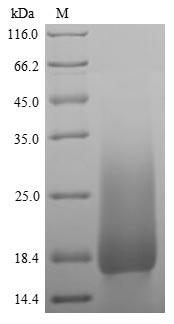Recombinant Mouse Lymphocyte antigen 6G (Ly6g) is produced in a yeast expression system and features an N-terminal 6xHis-tag for simplified purification. This partial protein contains amino acids 27 to 119 and achieves a purity greater than 90%, as confirmed by SDS-PAGE analysis. The product is designed for research use only, maintaining a low endotoxin level suitable for various experimental applications.
Lymphocyte antigen 6G (Ly6g) appears to be primarily linked to the immune system in mice. Researchers often use it as a marker for identifying neutrophils in immunological studies. Its role in the immune response may make it a valuable component in research focused on inflammation, infection, and related pathways, though the mechanisms likely provide insight into the behavior and regulation of immune cells.
Potential Applications
Note: The applications listed below are based on what we know about this protein's biological functions, published research, and experience from experts in the field. However, we haven't fully tested all of these applications ourselves yet. We'd recommend running some preliminary tests first to make sure they work for your specific research goals.
Based on the provided information, the folding state and bioactivity of this recombinant mouse Ly6g protein fragment are unknown and must be considered highly uncertain. Ly6g is a GPI-anchored protein that typically forms a characteristic three-finger structure stabilized by multiple disulfide bonds. While expression in a yeast system (eukaryotic) is favorable for disulfide bond formation compared to bacterial systems, the protein is expressed as a partial fragment (27-119aa) with an N-terminal 6xHis tag, which could potentially interfere with proper folding. The high purity by SEC-HPLC (>90%) suggests a monodisperse preparation, but this does not confirm correct disulfide bond formation or native structure. Without validation, the protein's ability to bind its natural ligands or receptors cannot be assumed. Applications relying on specific biological interactions are speculative.
1. Antibody Development and Validation
This recombinant Ly6g fragment is suitable for use as an immunogen to generate antibodies. The high purity and His-tag facilitate purification and screening. However, it is critical to note that the antibodies generated will be against this specific fragment. Their ability to recognize the natively folded, full-length, GPI-anchored Ly6g protein on the surface of mouse neutrophils is uncertain and must be rigorously validated. The presence of the His-tag may also lead to tag-specific antibodies that don't recognize the native protein.
2. Protein-Protein Interaction Studies
The His-tagged recombinant Ly6g protein can be immobilized for pull-down assays. However, the utility for identifying physiological binding partners is highly questionable. Ly6g's function involves specific cell-surface interactions that depend on its correct three-finger structure and membrane context. This cytosolic fragment, likely lacking proper disulfide bonding, will not present native binding surfaces. Any interactions identified are likely to be non-specific artifacts.
3. Biochemical Characterization Assays
This purified recombinant Ly6g protein is well-suited for basic biochemical characterization, including molecular weight confirmation, stability studies, and assessment of its solution behavior. This application is valid as it focuses on intrinsic physical properties independent of native bioactivity. The data characterizes this recombinant Ly6g fragment, not the native membrane Ly6g protein.
Final Recommendation & Action Plan
The recommended course of action is to restrict the use of this protein lot to Applications 1 (antibody development with the explicit understanding that antibodies may not recognize native Ly6g) and 3 (biophysical characterization of the fragment itself). Before any functional studies can be considered, the protein's folding must be validated using techniques like circular dichroism to assess secondary structure and non-reducing PAGE to check for disulfide bond formation. For meaningful cell binding or interaction studies, a full-length or properly structured Ly6g protein would need to be produced in a system that supports correct disulfide bonding and presented in a membrane-like context. The immediate step is to validate folding, not proceed with functional assays.







